 | –≠–ª–µ–∫—Ç—Ä–æ–Ω–Ω—ã–π –∫–æ–º–ø–æ–Ω–µ–Ω—Ç: L6207N | –°–∫–∞—á–∞—Ç—å:  PDF PDF  ZIP ZIP |
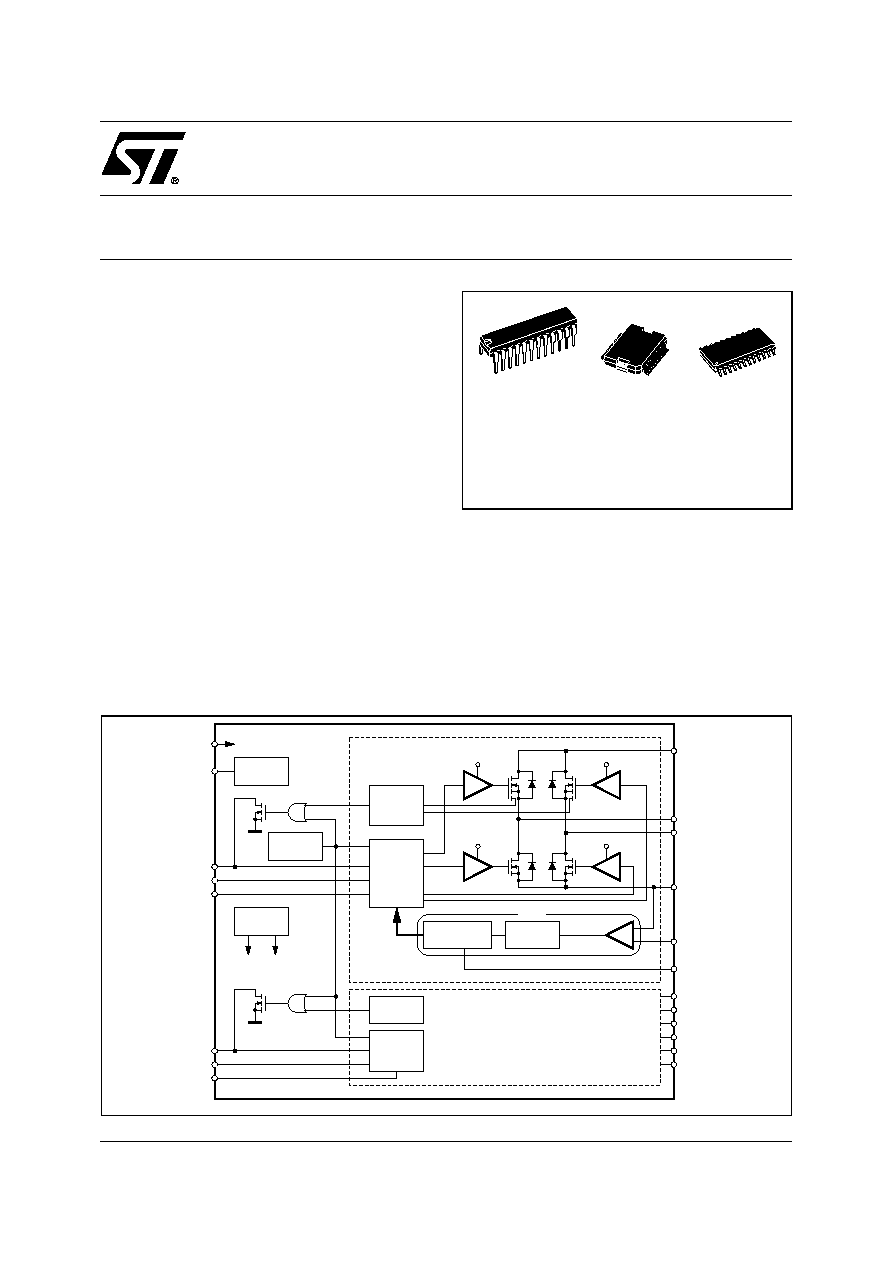
1/23
L6207
September 2003
s
OPERATING SUPPLY VOLTAGE FROM 8 TO 52V
s
5.6A OUTPUT PEAK CURRENT (2.8A DC)
s
R
DS(ON)
0.3
TYP. VALUE @ T
j
= 25 ∞C
s
OPERATING FREQUENCY UP TO 100KHz
s
NON DISSIPATIVE OVERCURRENT
PROTECTION
s
DUAL INDEPENDENT CONSTANT t
OFF
PWM
CURRENT CONTROLLERS
s
SLOW DECAY SYNCHRONOUS
RECTIFICATION
s
CROSS CONDUCTION PROTECTION
s
THERMAL SHUTDOWN
s
UNDER VOLTAGE LOCKOUT
s
INTEGRATED FAST FREE WHEELING DIODES
TYPICAL APPLICATIONS
s
BIPOLAR STEPPER MOTOR
s
DUAL DC MOTOR
DESCRIPTION
The L6207 is a DMOS Dual Full Bridge designed for
motor control applications, realized in MultiPower-
BCD technology, which combines isolated DMOS
Power Transistors with CMOS and bipolar circuits on
the same chip. The device also includes two inde-
pendent constant off time PWM Current Controllers
that performs the chopping regulation. Available in
PowerDIP24 (20+2+2), PowerSO36 and SO24
(20+2+2) packages, the L6207 features a non-dissi-
pative overcurrent protection on the high side Power
MOSFETs and thermal shutdown.
BLOCK DIAGRAM
D99IN1085A
GATE
LOGIC
OCD
A
OCD
B
OVER
CURRENT
DETECTION
OVER
CURRENT
DETECTION
GATE
LOGIC
VCP
VBOOT
EN
A
IN1
A
IN2
A
EN
B
IN1
B
IN2
B
VREF
A
V
BOOT
5V
10V
VS
A
V
S
B
OUT1
A
OUT2
A
OUT1
B
OUT2
B
SENSE
A
CHARGE
PUMP
VOLTAGE
REGULATOR
ONE SHOT
MONOSTABLE
MASKING
TIME
THERMAL
PROTECTION
V
BOOT
V
BOOT
10V
10V
BRIDGE A
SENSE
COMPARATOR
BRIDGE B
RC
A
+
-
SENSE
B
VREF
B
RC
B
PWM
ORDERING NUMBERS:
L6207N (PowerDIP24)
L6207PD (PowerSO36)
L6207D (SO24)
PowerDIP24
(20+2+2)
PowerSO36
SO24
(20+2+2)
DMOS DUAL FULL BRIDGE DRIVER
WITH PWM CURRENT CONTROLLER

L6207
2/23
ABSOLUTE MAXIMUM RATINGS
RECOMMENDED OPERATING CONDITIONS
Symbol
Parameter
Test conditions
Value
Unit
V
S
Supply Voltage
V
SA
= V
SB
= V
S
60
V
V
OD
Differential Voltage between
VS
A
, OUT1
A
, OUT2
A
, SENSE
A
and
VS
B
, OUT1
B
, OUT2
B
, SENSE
B
V
SA
= V
SB
= V
S
= 60V;
V
SENSEA
= V
SENSEB
= GND
60
V
V
BOOT
Bootstrap Peak Voltage
V
SA
= V
SB
= V
S
V
S
+ 10
V
V
IN
,V
EN
Input and Enable Voltage Range
-0.3 to +7
V
V
REFA
,
V
REFB
Voltage Range at pins V
REFA
and V
REFB
-0.3 to +7
V
V
RCA,
V
RCB
Voltage Range at pins RC
A
and
RC
B
-0.3 to +7
V
V
SENSEA,
V
SENSEB
Voltage Range at pins SENSE
A
and SENSE
B
-1 to +4
V
I
S(peak)
Pulsed Supply Current (for each
V
S
pin), internally limited by the
overcurrent protection
V
SA
= V
SB
= V
S
;
t
PULSE
< 1ms
7.1
A
I
S
RMS Supply Current (for each
V
S
pin)
V
SA
= V
SB
= V
S
2.8
A
T
stg
, T
OP
Storage and Operating
Temperature Range
-40 to 150
∞
C
Symbol
Parameter
Test Conditions
MIN
MAX
Unit
V
S
Supply Voltage
V
SA
= V
SB
= V
S
8
52
V
V
OD
Differential Voltage Between
VS
A
, OUT1
A
, OUT2
A
, SENSE
A
and
VS
B
, OUT1
B
, OUT2
B
, SENSE
B
V
SA
= V
SB
= V
S
;
V
SENSEA
= V
SENSEB
52
V
V
REFA
,
V
REFB
Voltage Range at pins V
REFA
and V
REFB
-0.1
5
V
V
SENSEA,
V
SENSEB
Voltage Range at pins SENSE
A
and SENSE
B
(pulsed t
W
< t
rr
)
(DC)
-6
-1
6
1
V
V
I
OUT
RMS Output Current
2.8
A
T
j
Operating Junction Temperature
-25
+125
∞C
f
sw
Switching Frequency
100
KHz
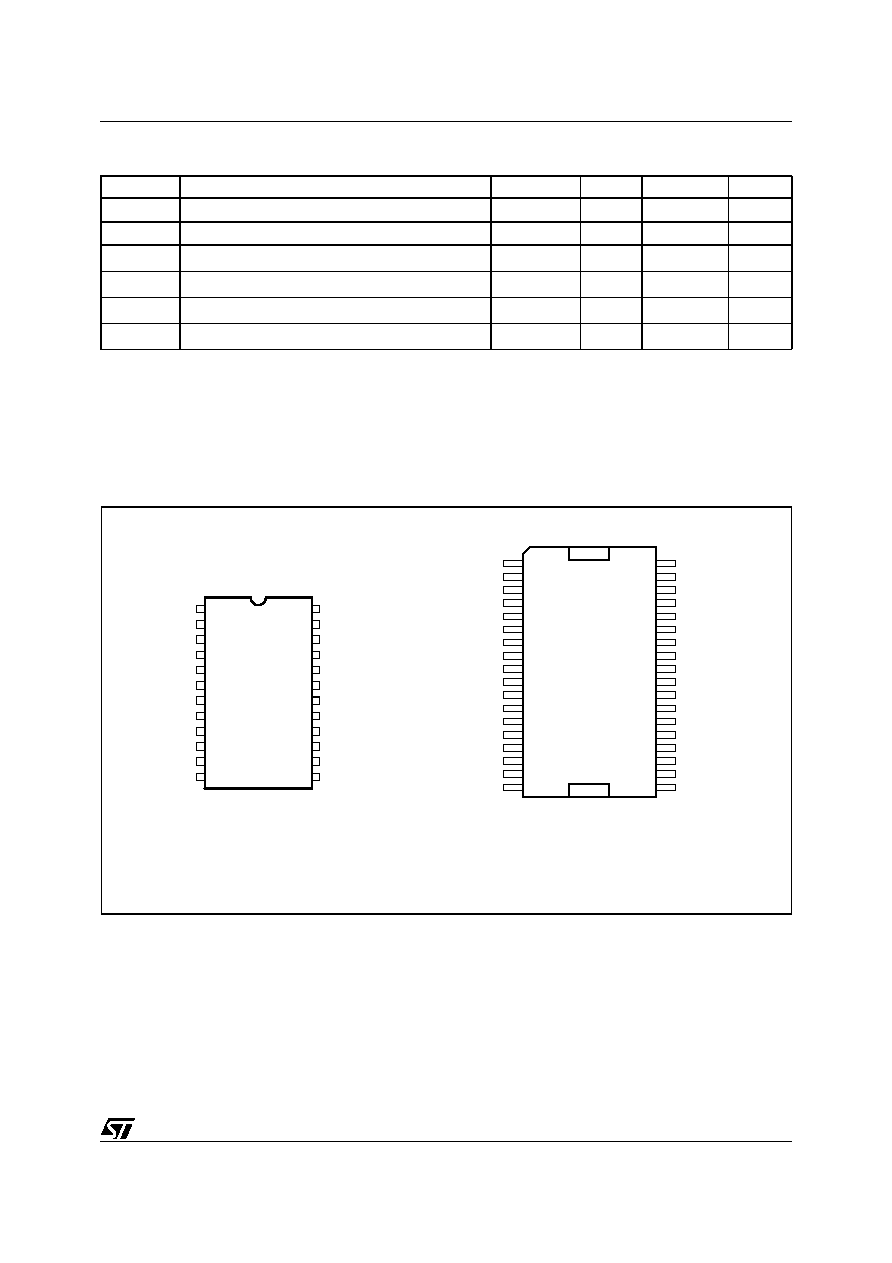
3/23
L6207
THERMAL DATA
PIN CONNECTIONS (Top View)
(5)
The slug is internally connected to pins 1,18,19 and 36 (GND pins).
Symbol
Description
PowerDIP24
SO24
PowerSO36
Unit
R
th-j-pins
Maximum Thermal Resistance Junction-Pins
18
14
-
∞
C/W
R
th-j-case
Maximum Thermal Resistance Junction-Case
-
-
1
∞
C/W
R
th-j-amb1
Maximum Thermal Resistance Junction-Ambient
1
(1)
Mounted on a multi-layer FR4 PCB with a dissipating copper surface on the bottom side of 6cm
2
(with a thickness of 35µm).
43
51
-
∞
C/W
R
th-j-amb1
Maximum Thermal Resistance Junction-Ambient
2
(2)
Mounted on a multi-layer FR4 PCB with a dissipating copper surface on the top side of 6cm
2
(with a thickness of 35µm).
-
-
35
∞
C/W
R
th-j-amb1
Maximum Thermal Resistance Junction-Ambient
3
(3)
Mounted on a multi-layer FR4 PCB with a dissipating copper surface on the top side of 6cm
2
(with a thickness of 35µm), 16 via holes
and a ground layer.
-
-
15
∞
C/W
R
th-j-amb2
Maximum Thermal Resistance Junction-Ambient
4
(4)
Mounted on a multi-layer FR4 PCB without any heat sinking surface on the board.
58
77
62
∞
C/W
PowerDIP24/SO24
PowerSO36
(5)
GND
GND
OUT1
B
RC
B
SENSE
B
IN2
B
IN1
B
1
3
2
4
5
6
7
8
9
VREF
B
VBOOT
EN
B
OUT2
B
VS
B
GND
GND
19
18
17
16
15
13
14
D02IN1346
10
11
12
24
23
22
21
20
IN1
A
IN2
A
SENSE
A
RC
A
OUT1
A
VS
A
OUT2
A
VCP
EN
A
VREF
A
GND
N.C.
N.C.
VS
A
RC
A
OUT1
A
N.C.
N.C.
N.C.
N.C.
N.C.
OUT1
B
RC
B
N.C.
VS
B
N.C.
N.C.
GND
18
16
17
15
6
5
4
3
2
21
22
31
32
33
35
34
36
20
1
19
GND
GND
D02IN1347
IN1
A
SENSE
A
IN2
A
SENSE
B
IN2
B
IN1
B
9
8
7
28
29
30
VREF
A
VREF
B
10
27
OUT2
A
EN
A
VCP
EN
B
OUT2
B
VBOOT
14
12
11
23
25
26
N.C.
N.C.
13
24

L6207
4/23
PIN DESCRIPTION
PACKAGE
Name
Type
Function
SO24/
PowerDIP24
PowerSO36
PIN #
PIN #
1
10
IN1
A
Logic input
Bridge A Logic Input 1.
2
11
IN2
A
Logic input
Bridge A Logic Input 2.
3
12
SENSE
A
Power Supply
Bridge A Source Pin. This pin must be connected to Power
Ground through a sensing power resistor.
4
13
RC
A
RC Pin
RC Network Pin. A parallel RC network connected
between this pin and ground sets the Current Controller
OFF-Time of the Bridge A.
5
15
OUT1
A
Power Output
Bridge A Output 1.
6, 7,
18, 19
1, 18,
19, 36
GND
GND
Signal Ground terminals. In Power DIP and SO packages,
these pins are also used for heat dissipation toward the
PCB.
8
22
OUT1
B
Power Output
Bridge B Output 1.
9
24
RC
B
RC Pin
RC Network Pin. A parallel RC network connected
between this pin and ground sets the Current Controller
OFF-Time of the Bridge B.
10
25
SENSE
B
Power Supply
Bridge B Source Pin. This pin must be connected to Power
Ground through a sensing power resistor.
11
26
IN1
B
Logic Input
Bridge B Input 1
12
27
IN2
B
Logic Input
Bridge B Input 2
13
28
VREF
B
Analog Input
Bridge B Current Controller Reference Voltage.
Do not leave this pin open or connect to GND.
14
29
EN
B
Logic Input
(6)
Bridge B Enable. LOW logic level switches OFF all Power
MOSFETs of Bridge B. This pin is also connected to the
collector of the Overcurrent and Thermal Protection
transistor to implement over current protection.
If not used, it has to be connected to +5V through a
resistor.
15
30
VBOOT
Supply
Voltage
Bootstrap Voltage needed for driving the upper Power
MOSFETs of both Bridge A and Bridge B.
16
32
OUT2
B
Power Output
Bridge B Output 2.
17
33
VS
B
Power Supply Bridge B Power Supply Voltage. It must be connected to
the supply voltage together with pin VS
A
.
20
4
VS
A
Power Supply
Bridge A Power Supply Voltage. It must be connected to
the supply voltage together with pin VS
B
.
21
5
OUT2
A
Power Output
Bridge A Output 2.
22
7
VCP
Output
Charge Pump Oscillator Output.

5/23
L6207
(6)
Also connected at the output drain of the Over current and Thermal protection MOSFET. Therefore, it has to be driven putting in
series a resistor with a value in the range of 2.2K
- 180K
, recommended 100K
.
23
8
EN
A
Logic Input
(6)
Bridge A Enable. LOW logic level switches OFF all Power
MOSFETs of Bridge A. This pin is also connected to the
collector of the Overcurrent and Thermal Protection
transistor to implement over current protection.
If not used, it has to be connected to +5V through a
resistor.
24
9
VREF
A
Analog Input
Bridge A Current Controller Reference Voltage.
Do not leave this pin open or connect to GND.
ELECTRICAL CHARACTERISTICS
(T
amb
= 25 ∞C, V
s
= 48V, unless otherwise specified)
Symbol
Parameter Test
Conditions
Min
Typ
Max
Unit
V
Sth(ON)
Turn-on Threshold
6.6
7
7.4
V
V
Sth(OFF)
Turn-off Threshold
5.6
6
6.4
V
I
S
Quiescent Supply Current
All Bridges OFF;
T
j
= -25∞C to 125∞C
(7)
5
10
mA
T
j(OFF)
Thermal Shutdown Temperature
165
∞
C
Output DMOS Transistors
R
DS(ON)
High-Side Switch ON Resistance T
j
= 25
∞
C
0.34
0.4
T
j
=125
∞
C
(7)
0.53
0.59
Low-Side Switch ON Resistance
T
j
= 25
∞
C
0.28
0.34
T
j
=125
∞
C
(7)
0.47
0.53
I
DSS
Leakage Current
EN = Low; OUT = V
S
2
mA
EN = Low; OUT = GND
-0.15
mA
Source Drain Diodes
V
SD
Forward ON Voltage
I
SD
= 2.8A, EN = LOW
1.15
1.3
V
t
rr
Reverse Recovery Time
I
f
= 2.8A
300
ns
t
fr
Forward Recovery Time
200
ns
Logic Input
V
IL
Low level logic input voltage
-0.3
0.8
V
V
IH
High level logic input voltage
2
7
V
I
IL
Low Level Logic Input Current
GND Logic Input Voltage
-10
µA
I
IH
High Level Logic Input Current
7V Logic Input Voltage
10
µA
V
th(ON)
Turn-on Input Threshold
1.8
2.0
V
V
th(OFF)
Turn-off Input Threshold
0.8
1.3
V
V
th(HYS)
Input Threshold Hysteresis
0.25
0.5
V
PIN DESCRIPTION (continued)

L6207
6/23
(7)
Tested at 25∞C in a restricted range and guaranteed by characterization.
(8)
See Fig. 1.
(9)
Measured applying a voltage of 1V to pin SENSE and a voltage drop from 2V to 0V to pin VREF.
(10)
See Fig. 2.
Switching Characteristics
t
D(on)EN
Enable to out turn ON delay time
(8)
I
LOAD
=2.8A, Resistive Load
100
250
400
ns
t
D(on)IN
Input to out turn ON delay time
I
LOAD
=2.8A, Resistive Load
(dead time included)
1.6
µs
t
RISE
Output rise time
(8)
I
LOAD
=2.8A, Resistive Load
40
250
ns
t
D(off)EN
Enable to out turn OFF delay time
(8)
I
LOAD
=2.8A, Resistive Load
300
550
800
ns
t
D(off)IN
Input to out turn OFF delay time
I
LOAD
=2.8A, Resistive Load
600
ns
t
FALL
Output Fall Time
(8)
I
LOAD
=2.8A, Resistive Load
40
250
ns
t
dt
Dead Time Protection
0.5
1
µs
f
CP
Charge pump frequency
-25∞C<T
j
<125∞C
0.6
1
MHz
PWM Comparator and Monostable
I
RCA,
I
RCB
Source Current at pins RC
A
and
RC
B
V
RCA
= V
RCB
= 2.5V
3.5
5.5
mA
V
offset
Offset Voltage on Sense
Comparator
V
REFA,
V
REFB
= 0.5V
±5
mV
t
PROP
Turn OFF Propagation Delay
(9)
500
ns
t
BLANK
Internal Blanking Time on
SENSE pins
1
µs
t
ON(MIN)
Minimum On Time
1.5
2
µs
t
OFF
PWM Recirculation Time
R
OFF
= 20K
;
C
OFF
= 1nF
13
µs
R
OFF
= 100K
;
C
OFF
= 1nF
61
µs
I
BIAS
Input Bias Current at pins VREF
A
and VREF
B
10
µA
Over Current Protection
I
SOVER
Input Supply Overcurrent
Protection Threshold
T
j
= -25∞C to 125∞C
(7)
4
5.6
7.1
A
R
OPDR
Open Drain ON Resistance
I = 4mA
40
60
t
OCD(ON)
OCD Turn-on Delay Time (10)
I = 4mA; C
EN
< 100pF
200
ns
t
OCD(OFF)
OCD Turn-off Delay Time (10)
I = 4mA; C
EN
< 100pF
100
ns
ELECTRICAL CHARACTERISTICS (continued)
(T
amb
= 25 ∞C, V
s
= 48V, unless otherwise specified)
Symbol
Parameter Test
Conditions
Min
Typ
Max
Unit
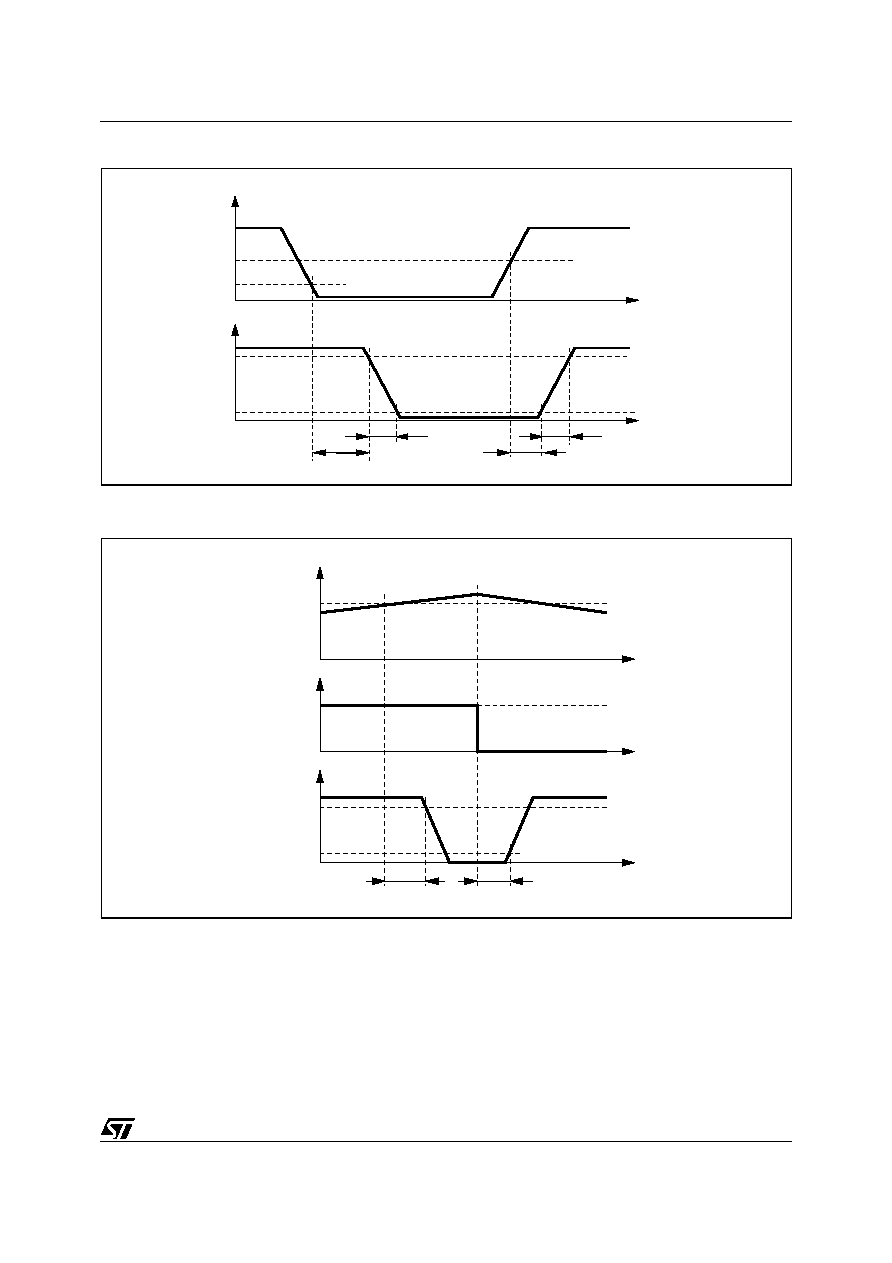
7/23
L6207
Figure 1. Switching Characteristic Definition
Figure 2. Overcurrent Detection Timing Definition
V
th(ON)
V
th(OFF)
90%
10%
EN
I
OUT
t
t
t
FALL
t
D(OFF)EN
t
RISE
t
D(ON)EN
D01IN1316
I
SOVER
90%
10%
I
OUT
V
EN
t
OCD(OFF)
t
OCD(ON)
D02IN1399
ON
OFF
BRIDGE
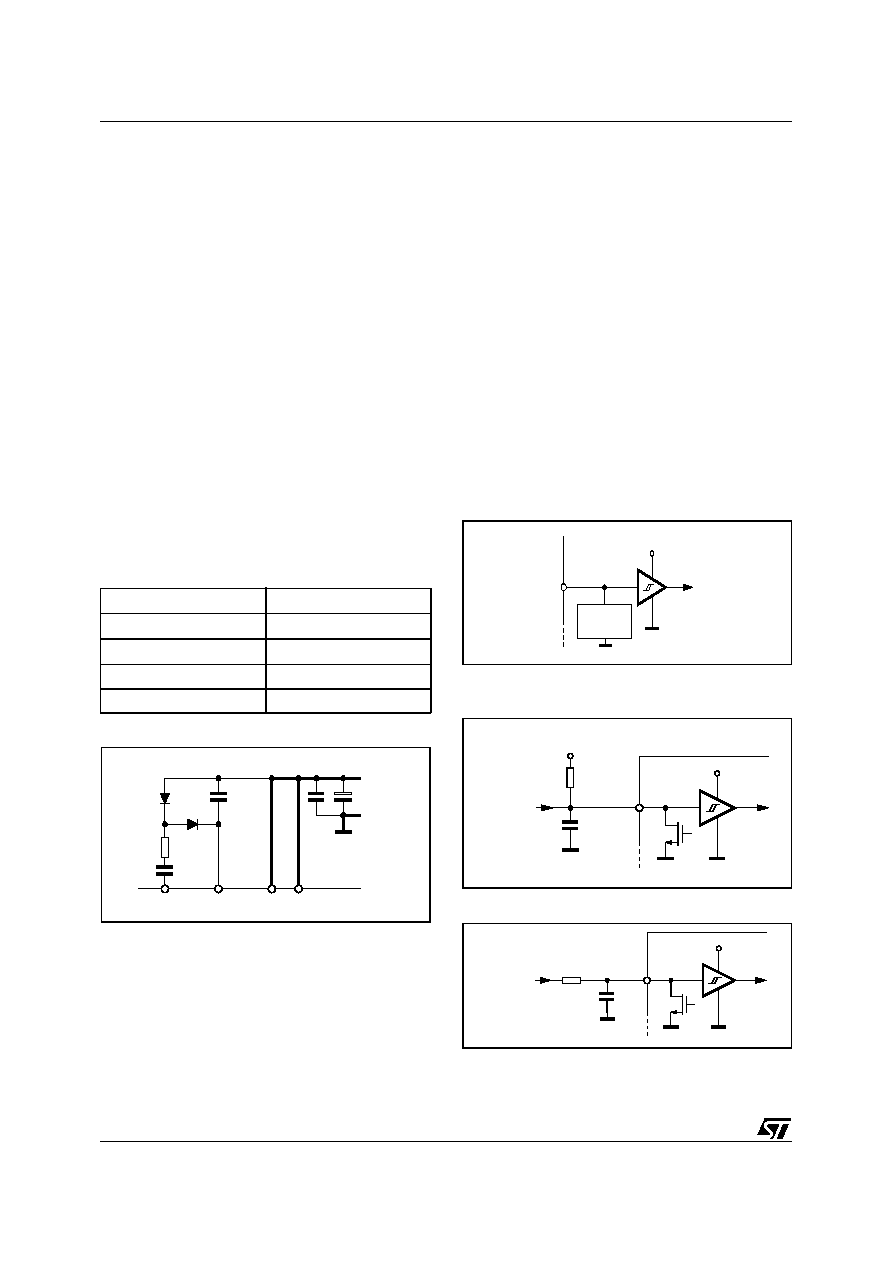
L6207
8/23
CIRCUIT DESCRIPTION
POWER STAGES and CHARGE PUMP
The L6207 integrates two independent Power MOS
Full Bridges. Each Power MOS has an Rdson =
0.3ohm (typical value @ 25∞C), with intrinsic fast
freewheeling diode. Cross conduction protection is
achieved using a dead time (td = 1
µ
s typical) be-
tween the switch off and switch on of two Power MOS
in one leg of a bridge.
Using N Channel Power MOS for the upper transis-
tors in the bridge requires a gate drive voltage above
the power supply voltage. The Bootstrapped
(VBOOT) supply is obtained through an internal Os-
cillator and few external components to realize a
charge pump circuit as shown in Figure 3. The oscil-
lator output (VCP) is a square wave at 600kHz (typi-
cal) with 10V amplitude. Recommended values/part
numbers for the charge pump circuit are shown in
Table1.
Table 1. Charge Pump External Components
Values
Figure 3. Charge Pump Circuit
LOGIC INPUTS
Pins IN1
A
, IN2
B
, IN1
B
and IN2
B
are TTL/CMOS and
uC compatible logic inputs. The internal structure is
shown in Fig. 4. Typical value for turn-on and turn-off
thresholds are respectively Vthon = 1.8V and Vthoff
= 1.3V.
Pins EN
A
and EN
B
have identical input structure with
the exception that the drains of the Overcurrent and
thermal protection MOSFETs (one for the Bridge A
and one for the Bridge B) are also connected to these
pins. Due to these connections some care needs to
be taken in driving these pins. The EN
A
and EN
B
in-
puts may be driven in one of two configurations as
shown in figures 5 or 6. If driven by an open drain
(collector) structure, a pull-up resistor R
EN
and a ca-
pacitor C
EN
are connected as shown in Fig. 5. If the
driver is a standard Push-Pull structure the resistor
R
EN
and the capacitor C
EN
are connected as shown
in Fig. 6. The resistor R
EN
should be chosen in the
range from 2.2k
to 180K
. Recommended values
for R
EN
and C
EN
are respectively 100K
and 5.6nF.
More information on selecting the values is found in
the Overcurrent Protection section.
Figure 4. Logic Inputs Internal Structure
Figure 5. EN
A
and EN
B
Pins Open Collector
Driving
Figure 6. EN
A
and EN
B
Pins Push-Pull Driving
C
BOOT
220nF
C
P
10nF
R
P
100
D1
1N4148
D2
1N4148
D2
C
BOOT
D1
R
P
C
P
V
S
VS
A
VCP
VBOOT
VS
B
D01IN1328
5V
D01IN1329
ESD
PROTECTION
5V
5V
OPEN
COLLECTOR
OUTPUT
R
EN
C
EN
EN
A
or EN
B
D02IN1349
5V
PUSH-PULL
OUTPUT
R
EN
C
EN
EN
A
or EN
B
D02IN1350
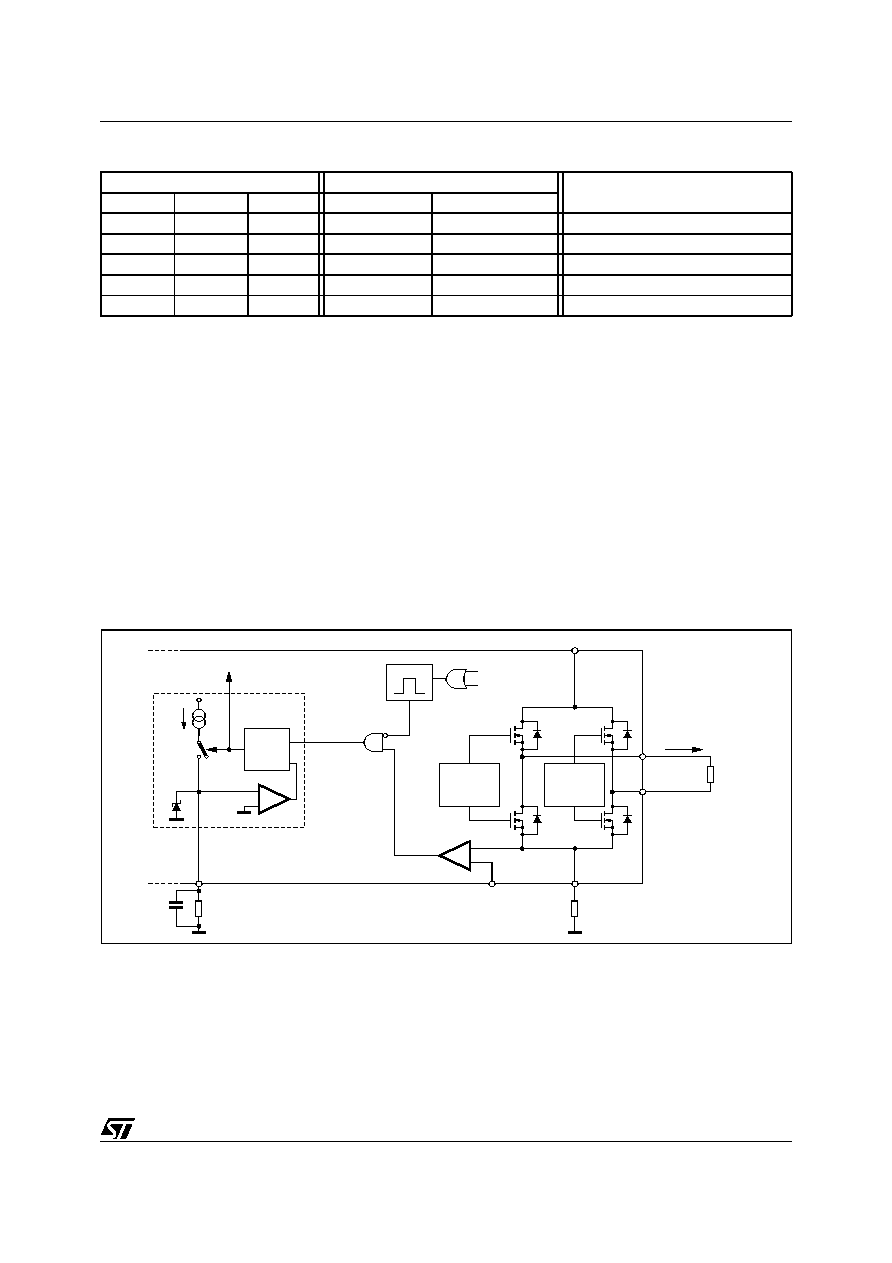
9/23
L6207
TRUTH TABLE
X
= Don't care
High Z
= High Impedance Output
GND (Vs)
= GND during Ton, Vs during Toff
(*) Valid only in case of load connected between OUT1 and OUT2
PWM CURRENT CONTROL
The L6207 includes a constant off time PWM current controller for each of the two bridges. The current control
circuit senses the bridge current by sensing the voltage drop across an external sense resistor connected be-
tween the source of the two lower power MOS transistors and ground, as shown in Figure 7. As the current in
the load builds up the voltage across the sense resistor increases proportionally. When the voltage drop across
the sense resistor becomes greater than the voltage at the reference input (VREF
A
or VREF
B
) the sense com-
parator triggers the monostable switching the low-side MOS off. The low-side MOS remain off for the time set
by the monostable and the motor current recirculates in the upper path. When the monostable times out the
bridge will again turn on. Since the internal dead time, used to prevent cross conduction in the bridge, delays
the turn on of the power MOS, the effective off time is the sum of the monostable time plus the dead time.
Figure 7. PWM Current Controller Simplified Schematic
Figure 8 shows the typical operating waveforms of the output current, the voltage drop across the sensing re-
sistor, the RC pin voltage and the status of the bridge. Immediately after the low-side Power MOS turns on, a
high peak current flows through the sensing resistor due to the reverse recovery of the freewheeling diodes. The
L6207 provides a 1
µ
s Blanking Time t
BLANK
that inhibits the comparator output so that this current spike cannot
prematurely re-trigger the monostable.
INPUTS
OUTPUTS
Description (*)
EN
IN1
IN2
OUT1
OUT2
L
X
X
High Z
High Z
Disable
H
L
L
GND
GND
Brake Mode (Lower Path)
H
H
L
Vs
GND (Vs)
Forward
H
L
H
GND (Vs)
Vs
Reverse
H
H
H
Vs
Vs
Brake Mode (Upper Path)
DRIVERS
+
DEAD TIME
S
Q
R
DRIVERS
+
DEAD TIME
2H
1H
2L
1L
OUT2A(or B)
SENSEA(or B)
RSENSE
D02IN1352
RCA(or B)
R
C
VREFA(or B)
IOUT
OUT1A(or B)
+
+
-
-
1
µ
s
5mA
BLANKER
SENSE
COMPARATOR
COMPARATOR
OUTPUT
MONOSTABLE
RESET
2.5V
5V
FROM THE
LOW-SIDE
GATE DRIVERS
LOAD
A
(or
B
)
BLANKING TIME
MONOSTABLE
VS
A
(or B)
TO GATE LOGIC
(0)
(1)

L6207
10/23
Figure 8. Output Current Regulation Waveforms
Figure 9 shows the magnitude of the Off Time t
OFF
versus C
OFF
and R
OFF
values. It can be approximately cal-
culated from the equations:
t
RCFALL
= 0.6 ∑ R
OFF
∑ C
OFF
t
OFF
= t
RCFALL
+ t
DT
= 0.6 ∑ R
OFF
∑ C
OFF
+ t
DT
where R
OFF
and C
OFF
are the external component values and t
DT
is the internally generated Dead Time with:
20K
R
OFF
100K
0.47nF
C
OFF
100nF
t
DT
= 1µs (typical value)
Therefore:
t
OFF(MIN)
= 6.6µs
t
OFF(MAX)
= 6ms
These values allow a sufficient range of t
OFF
to implement the drive circuit for most motors.
The capacitor value chosen for C
OFF
also affects the Rise Time t
RCRISE
of the voltage at the pin RCOFF. The
Rise Time t
RCRISE
will only be an issue if the capacitor is not completely charged before the next time the
monostable is triggered. Therefore, the on time t
ON
, which depends by motors and supply parameters, has to
OFF
B
C
D
D
A
t
ON
t
OFF
B
C
ON
2.5V
0
Slow Decay
Slow Decay
1
µ
s t
BLANK
t
RCRISE
t
RCRISE
SYNCHRONOUS RECTIFICATION
1
µ
s t
BLANK
5V
V
RC
V
SENSE
V
REF
I
OUT
V
REF
R
SENSE
D02IN1351
t
OFF
1
µ
s t
DT
1
µ
s t
DT
t
RCFALL
t
RCFALL

11/23
L6207
be bigger than t
RCRISE
for allowing a good current regulation by the PWM stage. Furthermore, the on time t
ON
can not be smaller than the minimum on time t
ON(MIN)
.
t
RCRISE
= 600 ∑ C
OFF
Figure 10 shows the lower limit for the on time t
ON
for having a good PWM current regulation capacity. It has to
be said that t
ON
is always bigger than t
ON(MIN)
because the device imposes this condition, but it can be smaller
than t
RCRISE
- t
DT
. In this last case the device continues to work but the off time t
OFF
is not more constant.
So, small C
OFF
value gives more flexibility for the applications (allows smaller on time and, therefore, higher
switching frequency), but, the smaller is the value for C
OFF
, the more influential will be the noises on the circuit
performance.
Figure 9. t
OFF
versus C
OFF
and R
OFF
t
O N
t
O N MIN
(
)
>
1.5
µ
s (typ. value)
=
t
O N
t
R C R IS E
t
D T
≠
>
0.1
1
10
100
1
10
100
1 .10
3
1 .10
4
Coff [nF]
toff
[
µ
s]
R
off
= 100k
R
off
= 47k
R
off
= 20k

L6207
12/23
Figure 10. Area where t
ON
can vary maintaining the PWM regulation.
SLOW DECAY MODE
Figure 11 shows the operation of the bridge in the Slow Decay mode. At the start of the off time, the lower power
MOS is switched off and the current recirculates around the upper half of the bridge. Since the voltage across
the coil is low, the current decays slowly. After the dead time the upper power MOS is operated in the synchro-
nous rectification mode. When the monostable times out, the lower power MOS is turned on again after some
delay set by the dead time to prevent cross conduction.
Figure 11. Slow Decay Mode Output Stage Configurations
0.1
1
10
100
1
10
100
Coff [nF]
t
o
n(
mi
n)
[
µ
s]
1.5
µ
s (typ. value)
A) ON TIME
B) 1
µ
s DEAD TIME
C) SYNCHRONOUS
RECTIFICATION
D) 1
µ
s DEAD TIME
D01IN1336
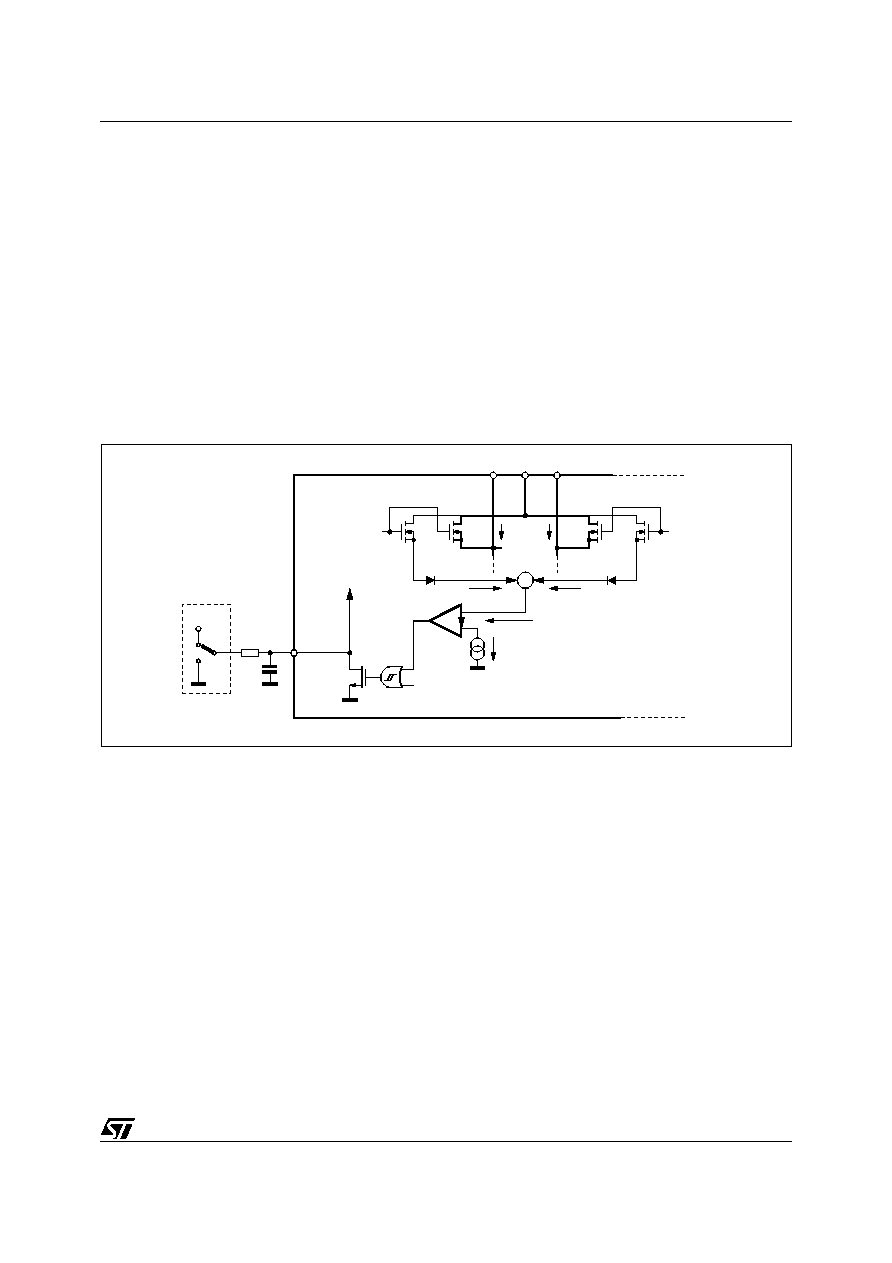
13/23
L6207
NON-DISSIPATIVE OVERCURRENT PROTECTION
The L6207 integrates an Overcurrent Detection Circuit (OCD). This circuit provides protection against a short
circuit to ground or between two phases of the bridge. With this internal over current detection, the external cur-
rent sense resistor normally used and its associated power dissipation are eliminated. Figure 12 shows a sim-
plified schematic of the overcurrent detection circuit.
To implement the over current detection, a sensing element that delivers a small but precise fraction of the out-
put current is implemented with each high side power MOS. Since this current is a small fraction of the output
current there is very little additional power dissipation. This current is compared with an internal reference cur-
rent I
REF
. When the output current in one bridge reaches the detection threshold (typically 5.6A) the relative
OCD comparator signals a fault condition. When a fault condition is detected, the EN pin is pulled below the turn
off threshold (1.3V typical) by an internal open drain MOS with a pull down capability of 4mA. By using an ex-
ternal R-C on the EN pin, the off time before recovering normal operation can be easily programmed by means
of the accurate thresholds of the logic inputs.
Figure 12. Overcurrent Protection Simplified Schematic
Figure 13 shows the Overcurrent Detection operation. The Disable Time t
DISABLE
before recovering normal oper-
ation can be easily programmed by means of the accurate thresholds of the logic inputs. It is affected whether by
C
EN
and R
EN
values and its magnitude is reported in Figure 14. The Delay Time t
DELAY
before turning off the
bridge when an overcurrent has been detected depends only by C
EN
value. Its magnitude is reported in Figure 15.
C
EN
is also used for providing immunity to pin EN against fast transient noises. Therefore the value of C
EN
should be chosen as big as possible according to the maximum tolerable Delay Time and the R
EN
value should
be chosen according to the desired Disable Time.
The resistor R
EN
should be chosen in the range from 2.2K
to 180K
. Recommended values for R
EN
and C
EN
are respectively 100K
and 5.6nF that allow obtaining 200
µ
s Disable Time.
+
OVER TEMPERATURE
I
REF
(I
1A
+I
2A
) / n
I
1A
/ n
POWER SENSE
1 cell
POWER SENSE
1 cell
POWER DMOS
n cells
POWER DMOS
n cells
HIGH SIDE DMOSs OF
THE BRIDGE A
OUT1
A
OUT2
A
VS
A
I
1A
I
2A
I
2A
/ n
OCD
COMPARATOR
TO GATE
LOGIC
INTERNAL
OPEN-DRAIN
R
DS(ON)
40
TYP.
C
EN
R
EN
EN
A
+5V
µ
C or LOGIC
D02IN1353

L6207
14/23
Figure 13. Overcurrent Protection Waveforms
I
SOVER
I
OUT
V
th(ON)
V
th(OFF)
V
EN(LOW)
V
DD
t
OCD(ON)
t
D(ON)EN
t
EN(FALL)
t
EN(RISE)
t
DISABLE
t
DELAY
t
OCD(OFF)
t
D(OFF)EN
V
EN
BRIDGE
ON
OFF
OCD
ON
OFF
D02IN1400
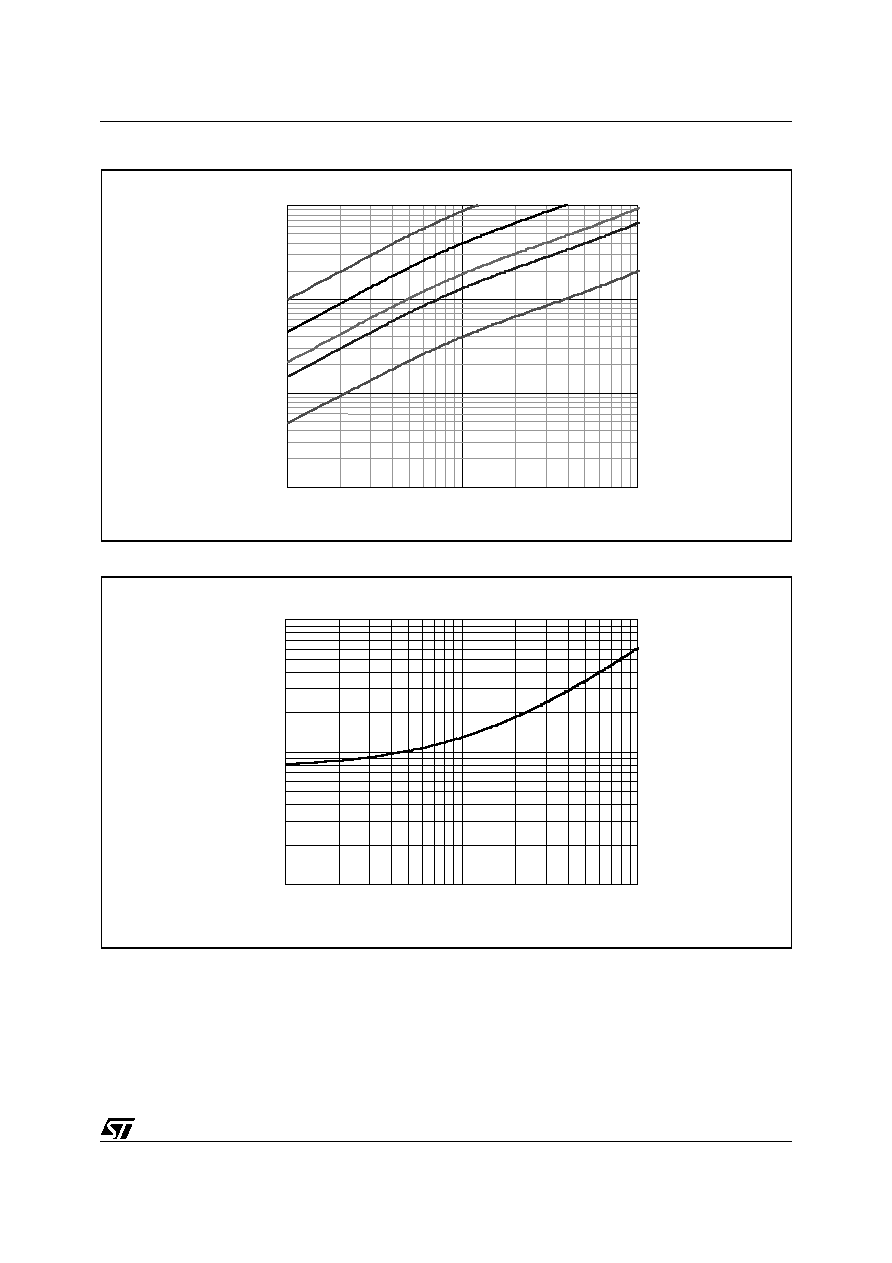
15/23
L6207
Figure 14. t
DISABLE
versus C
EN
and R
EN
(V
DD
= 5V).
Figure 15. t
DELAY
versus C
EN
(V
DD
= 5V).
THERMAL PROTECTION
In addition to the Ovecurrent Protection, the L6207 integrates a Thermal Protection for preventing the device
destruction in case of junction over temperature. It works sensing the die temperature by means of a sensible
element integrated in the die. The device switch-off when the junction temperature reaches 165∞C (typ. value)
with 15∞C hysteresis (typ. value).
1
1 0
1 0 0
1
1 0
1 0 0
1
.
1 0
3
C
E N
[n F ]
t
DIS
AB
L
E
[µ
s
]
R
E N
= 2 2 0 k
R
E N
= 1 0 0 k
R
E N
= 4 7 k
R
E N
= 3 3 k
R
E N
= 1 0 k
1
1 0
1 0 0
1
1 0
1 0 0
1
.
1 0
3
C
E N
[n F ]
t
DIS
AB
L
E
[µ
s
]
R
E N
= 2 2 0 k
R
E N
= 1 0 0 k
R
E N
= 4 7 k
R
E N
= 3 3 k
R
E N
= 1 0 k
1
10
100
0.1
1
10
Cen [nF]
t
d
el
ay
[
µ
s]

L6207
16/23
APPLICATION INFORMATION
A typical application using L6207 is shown in Fig. 16. Typical component values for the application are shown
in Table 3. A high quality ceramic capacitor in the range of 100 to 200 nF should be placed between the power
pins (VS
A
and VS
B
) and ground near the L6207 to improve the high frequency filtering on the power supply and
reduce high frequency transients generated by the switching. The capacitors connected from the EN
A
and EN
B
inputs to ground set the shut down time for the BrgidgeA and BridgeB respectively when an over current is de-
tected (see Overcurrent Protection). The two current sensing inputs (SENSE
A
and SENSE
B
) should be connect-
ed to the sensing resistors with a trace length as short as possible in the layout. The sense resistors should be
non-inductive resistors to minimize the di/dt transients across the resistor. To increase noise immunity, unused
logic pins (except EN
A
and EN
B
) are best connected to 5V (High Logic Level) or GND (Low Logic Level) (see
pin description). It is recommended to keep Power Ground and Signal Ground separated on PCB.
Table 2. Component Values for Typical Application
Figure 16. Typical Application
C
1
100uF
D
1
1N4148
C
2
100nF
D
2
1N4148
C
A
1nF
R
A
39K
C
B
1nF
R
B
39K
C
BOOT
220nF
R
ENA
100K
C
P
10nF
R
ENB
100K
C
ENA
5.6nF
R
P
100
C
ENB
5.6nF
R
SENSEA
0.3
C
REFA
68nF
R
SENSEB
0.3
C
REFB
68nF
OUT1
A
LOAD
A
LOAD
B
VREF
A
VREF
B
1
5
21
18
19
8
16
OUT2
A
GND
GND
GND
GND
RC
A
OUT2
B
OUT1
B
VS
A
POWER
GROUND
SIGNAL
GROUND
+
-
VS
8-52V
DC
24
VS
B
VCP
VBOOT
C
P
C
BOOT
R
P
D
2
D
1
C
1
C
2
SENSE
A
R
SENSEA
20
IN1
A
IN2
A
IN1
A
IN2
A
2
6
7
13
EN
A
EN
B
C
ENB
R
ENB
R
ENA
EN
A
EN
B
V
REFA
= 0-1V
V
REFB
= 0-1V
23
IN2
B
12
IN1
B
IN2
B
IN1
B
11
14
4
17
3
15
22
SENSE
B
R
SENSEB
C
A
R
A
10
C
REFA
C
REFB
C
ENA
RC
B
9
C
B
R
B
D02IN1343
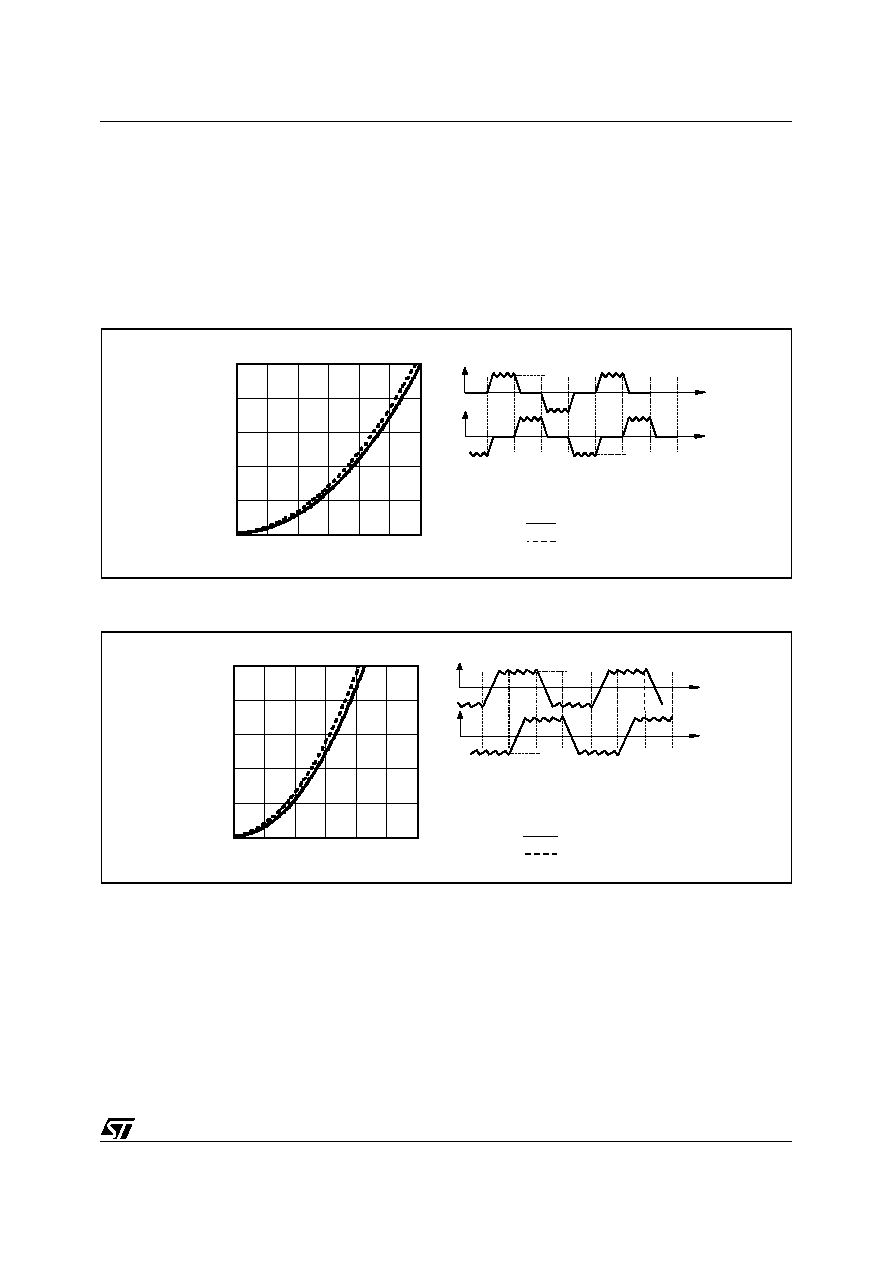
17/23
L6207
OUTPUT CURRENT CAPABILITY AND IC POWER DISSIPATION
In Fig. 17 and Fig. 18 are shown the approximate relation between the output current and the IC power dissipa-
tion using PWM current control driving two loads, for two different driving types:
≠ One Full Bridge ON at a time (Fig.17) in which only one load at a time is energized.
≠ Two Full Bridges ON at the same time (Fig.18) in which two loads at the same time are energized.
For a given output current and driving type the power dissipated by the IC can be easily evaluated, in order to
establish which package should be used and how large must be the on-board copper dissipating area to guar-
antee a safe operating junction temperature (125∞C maximum).
Figure 17. IC Power Dissipation versus Output Current with One Full Bridge ON at a time.
Figure 18. IC Power Dissipation versus Output Current with Two Full Bridges ON at the same time.
THERMAL MANAGEMENT
In most applications the power dissipation in the IC is the main factor that sets the maximum current that can be de-
livered by the device in a safe operating condition. Therefore, it has to be taken into account very carefully. Besides
the available space on the PCB, the right package should be chosen considering the power dissipation. Heat sinking
can be achieved using copper on the PCB with proper area and thickness. Figures 20, 21 and 22 show the Junction-
to-Ambient Thermal Resistance values for the PowerSO36, PowerDIP24 and SO24 packages.
For instance, using a PowerSO package with copper slug soldered on a 1.5 mm copper thickness FR4 board
with 6cm
2
dissipating footprint (copper thickness of 35µm), the R
th j-amb
is about 35∞C/W. Fig. 19 shows mount-
ing methods for this package. Using a multi-layer board with vias to a ground plane, thermal impedance can be
reduced down to 15∞C/W.
No PWM
f
SW
= 3 0 kHz (slow decay)
Test Conditions:
Supply Voltage = 24V
I
A
I
B
I
OUT
I
OUT
0
0.5
1
1.5
2
2.5
3
0
2
4
6
8
10
P
D
[W]
I
OUT
[A]
ONE FULL BRIDGE ON AT A TIME
No PWM
f
SW
= 30 kHz (slow decay)
Test Conditions:
Supply Voltage = 24V
I
A
I
B
I
OUT
I
OUT
0
0.5
1
1.5
2
2.5
3
0
2
4
6
8
10
P
D
[W ]
I
OUT
[A ]
TWO FULL BRIDGES ON AT THE SAME TIME

L6207
18/23
Figure 19. Mounting the PowerSO package.
Figure 20. PowerSO36 Junction-Ambient thermal resistance versus on-board copper area.
Figure 21. PowerDIP24 Junction-Ambient thermal resistance versus on-board copper area.
Figure 22. SO24 Junction-Ambient thermal resistance versus on-board copper area.
Slug soldered
to PCB with
dissipating area
Slug soldered
to PCB with
dissipating area
plus ground layer
Slug soldered to PCB with
dissipating area plus ground layer
contacted through via holes
13
18
23
28
33
38
43
1
2
3
4
5
6
7
8
9
10
1 1
1 2
13
W ith o ut G ro u nd La yer
W ith Gr o un d La yer
W ith Gr o un d La yer + 16 via
H o le s
s q . c m
∫C / W
On-Board Copper Area
39
40
41
42
43
44
45
46
47
48
49
1
2
3
4
5
6
7
8
9
10
11
12
C o p pe r Are a is o n Bo tto m
S id e
C o p pe r Are a is o n To p S i de
s q . cm
∫ C / W
On-Board Copper Area
48
50
52
54
56
58
60
62
64
66
68
1
2
3
4
5
6
7
8
9
10
11
12
C o pp er A re a is o n T op S id e
s q. cm
∫C / W
On-Board Copper Area

19/23
L6207
Figure 23. Typical Quiescent Current vs.
Supply Voltage
Figure 24. Normalized Typical Quiescent
Current vs. Switching Frequency
Figure 25. Typical Low-Side R
DS(ON)
vs.
Supply Voltage
Figure 26. Typical High-Side RDS(ON) vs.
Supply Voltage
Figure 27. Normalized R
DS(ON)
vs.Junction
Temperature (typical value)
Figure 28. Typical Drain-Source Diode
Forward ON Characteristic
4 .6
4 .8
5 .0
5 .2
5 .4
5 .6
0
10
2 0
3 0
40
5 0
6 0
Iq [m A ]
V
S
[V ]
f
sw
= 1kHz
T
j
= 25∞C
T
j
= 85∞C
T
j
= 125∞C
0.9
1.0
1.1
1.2
1.3
1.4
1.5
1.6
1.7
0
20
40
60
80
100
Iq / (Iq @ 1 kHz)
f
SW
[kHz]
0.276
0.280
0.284
0.288
0.292
0.296
0.300
0
5
10
15
20
25
30
R
DS(ON)
[
]
V
S
[V]
T
j
= 25∞C
0.336
0.340
0.344
0.348
0.352
0.356
0.360
0.364
0.368
0.372
0.376
0.380
0
5
10
15
20
25
30
R
DS(ON)
[
]
V
S
[V]
T
j
= 25∞C
0.8
1.0
1.2
1.4
1.6
1.8
0
20
40
60
80
100
120
140
R
DS(ON)
/ (R
DS(ON)
@ 25 ∞C )
Tj [∞C]
0.0
0.5
1.0
1.5
2.0
2.5
3.0
700
800
900
1000
1100
1200
1300
I
SD
[A]
V
SD
[mV]
T
j
= 25∞C

L6207
20/23
DIM.
mm
inch
MIN.
TYP.
MAX.
MIN.
TYP.
MAX.
A
3.60
0.141
a1
0.10
0.30
0.004
0.012
a2
3.30
0.130
a3
0
0.10
0
0.004
b
0.22
0.38
0.008
0.015
c
0.23
0.32
0.009
0.012
D (1)
15.80
16.00
0.622
0.630
D1
9.40
9.80
0.370
0.385
E
13.90
14.50
0.547
0.570
e
0.65
0.0256
e3
11.05
0.435
E1 (1)
10.90
11.10
0.429
0.437
E2
2.90
0.114
E3
5.80
6.20
0.228
0.244
E4
2.90
3.20
0.114
0.126
G
0
0.10
0
0.004
H
15.50
15.90
0.610
0.626
h
1.10
0.043
L
0.80
1.10
0.031
0.043
N
10
∞
(max.)
S
8
∞
(max.)
(1): "D" and "E1" do not include mold flash or protrusions
- Mold flash or protrusions shall not exceed 0.15mm (0.006 inch)
- Critical dimensions are "a3", "E" and "G".
PowerSO36
e
a2
A
E
a1
PSO36MEC
DETAIL A
D
1
1
8
19
36
E1
E2
h x 45∞
DETAIL A
lead
slug
a3
S
Gage Plane
0.35
L
DETAIL B
DETAIL B
(COPLANARITY)
G
C
- C -
SEATING PLANE
e3
c
N
N
M
0.12
A B
b
B
A
H
E3
D1
BOTTOM VIEW
OUTLINE AND
MECHANICAL DATA
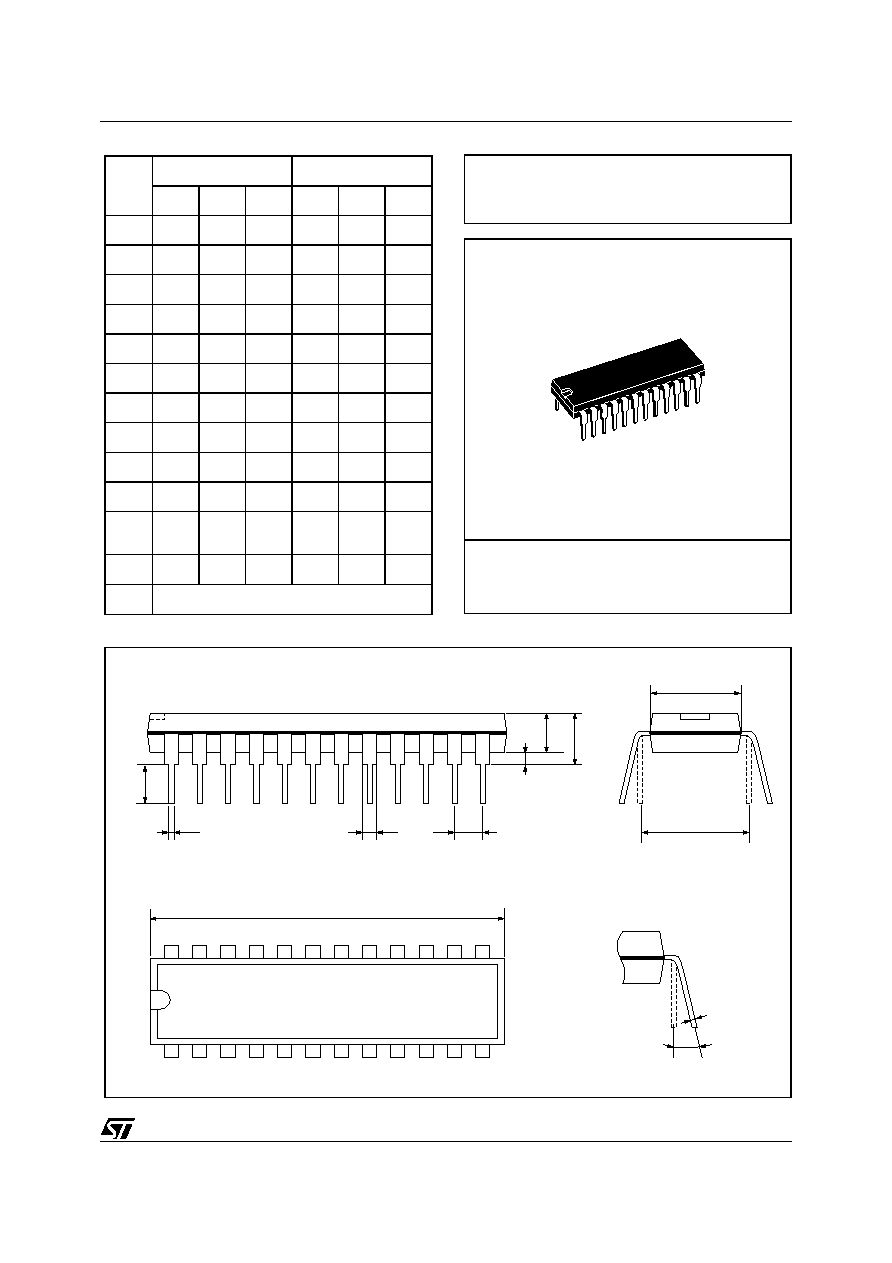
21/23
L6207
DIM.
mm
inch
MIN.
TYP.
MAX.
MIN.
TYP.
MAX.
A
4.320
0.170
A1
0.380
0.015
A2
3.300
0.130
B
0.410
0.460
0.510
0.016
0.018
0.020
B1
1.400
1.520
1.650
0.055
0.060
0.065
c
0.200
0.250
0.300
0.008
0.010
0.012
D
31.62
31.75
31.88
1.245
1.250
1.255
E
7.620
8.260
0.300
0.325
e
2.54
0.100
E1
6.350
6.600
6.860
0.250
0.260
0.270
e1
7.620
0.300
L
3.180
3.430
0.125
0.135
M
0∞ min, 15∞ max.
Powerdip 24
A1
B
e
B1
D
13
12
24
1
L
A
e1
A2
c
E1
SDIP24L
M
OUTLINE AND
MECHANICAL DATA
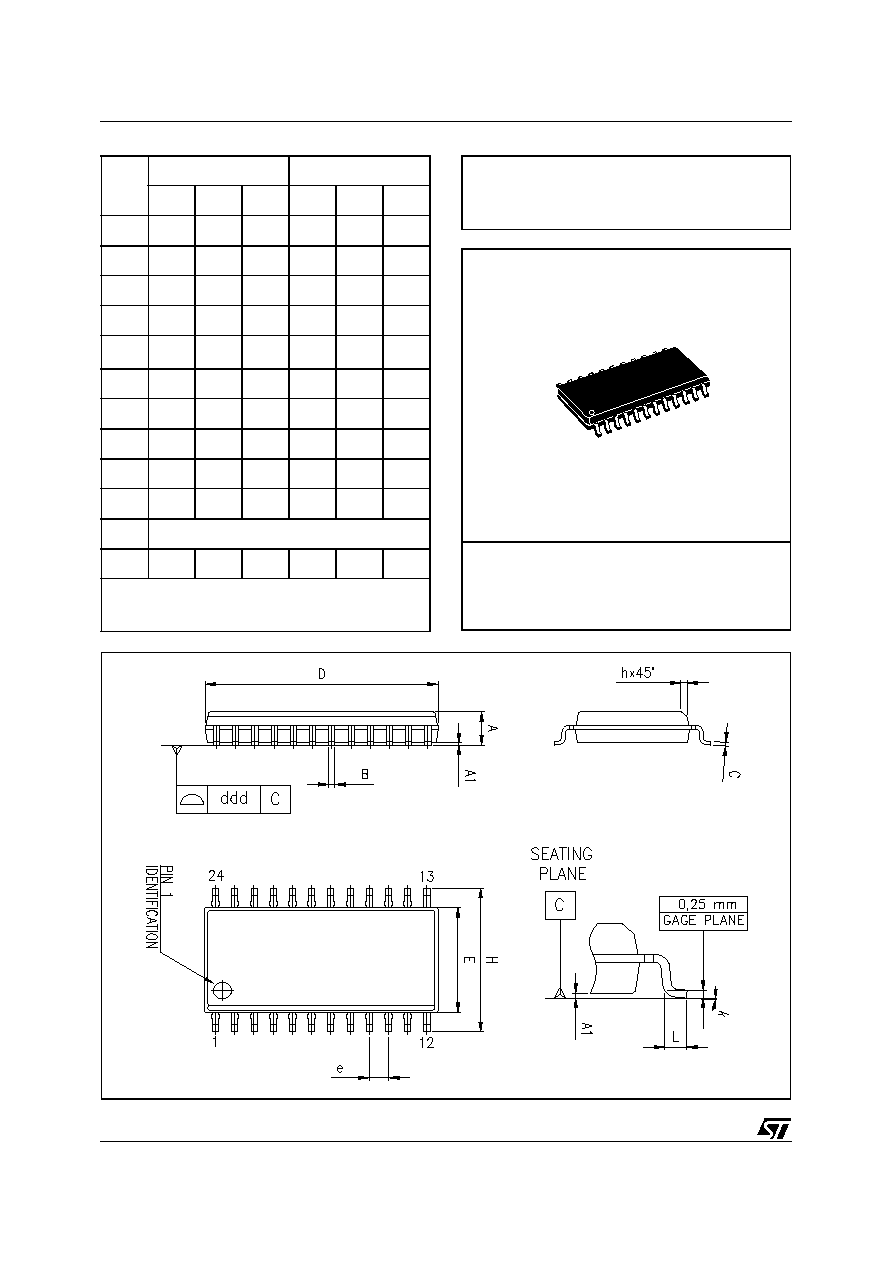
L6207
22/23
OUTLINE AND
MECHANICAL DATA
DIM.
mm
inch
MIN.
TYP.
MAX.
MIN.
TYP.
MAX.
A
2.35
2.65
0.093
0.104
A1
0.10
0.30
0.004
0.012
B
0.33
0.51
0.013
0.200
C
0.23
0.32
0.009
0.013
D
(1)
15.20
15.60
0.598
0.614
E
7.40
7.60
0.291
0.299
e
1.27
0.050
H
10.0
10.65
0.394
0.419
h
0.25
0;75
0.010
0.030
L
0.40
1.27
0.016
0.050
k
0∞ (min.), 8∞ (max.)
ddd
0.10
0.004
(1) "D" dimension does not include mold flash, protusions or gate
burrs. Mold flash, protusions or gate burrs shall not exceed
0.15mm per side.
SO24
0070769 C
Weight: 0.60gr

Information furnished is believed to be accurate and reliable. However, STMicroelectronics assumes no responsibility for the consequences
of use of such information nor for any infringement of patents or other rights of third parties which may result from its use. No license is granted
by implication or otherwise under any patent or patent rights of STMicroelectronics. Specifications mentioned in this publication are subject
to change without notice. This publication supersedes and replaces all information previously supplied. STMicroelectronics products are not
authorized for use as critical components in life support devices or systems without express written approval of STMicroelectronics.
The ST logo is a registered trademark of STMicroelectronics.
All other names are the property of their respective owners
© 2003 STMicroelectronics - All rights reserved
STMicroelectronics GROUP OF COMPANIES
Australia - Belgium - Brazil - Canada - China - Czech Republic - Finland - France - Germany - Hong Kong - India - Israel - Italy - Japan -
Malaysia - Malta - Morocco - Singapore - Spain - Sweden - Switzerland - United Kingdom - United States
www.st.com
23/23
L6207






















